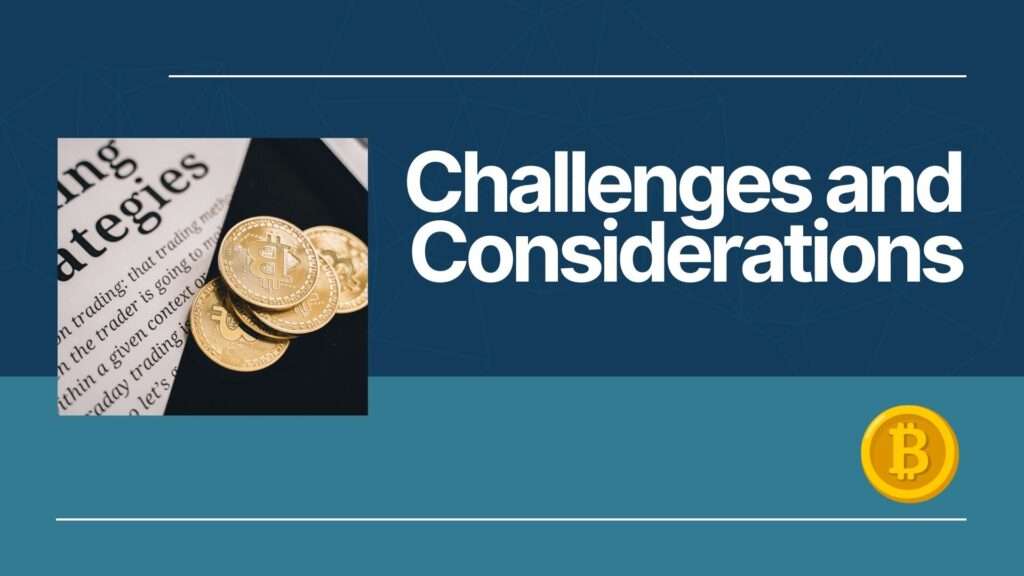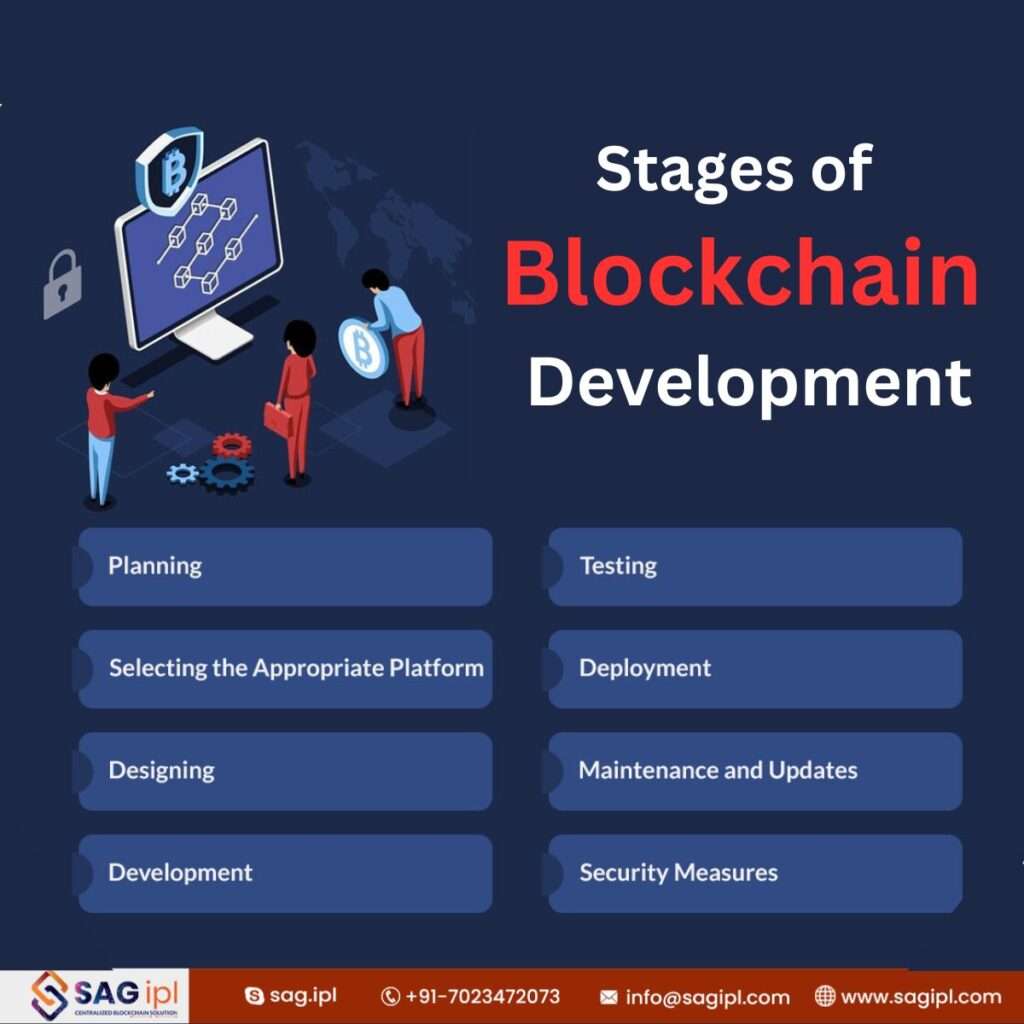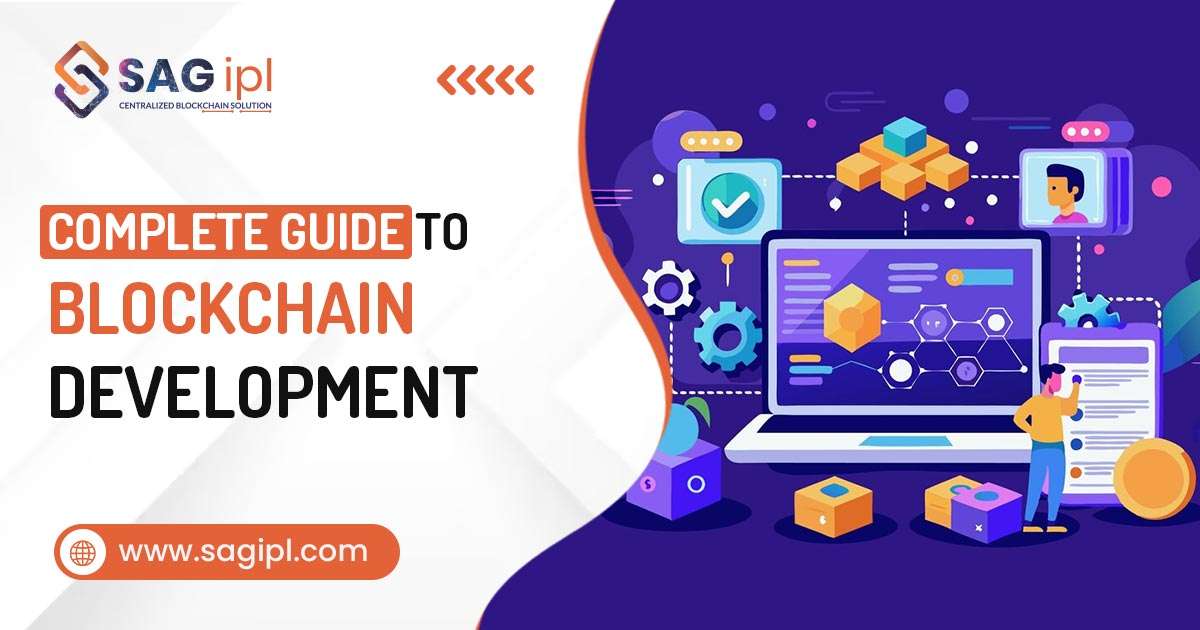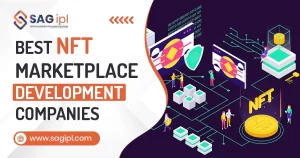Today blockchain technology is emerging as a transformative force across various industries.
As of 2023, the global blockchain market is projected to reach a staggering $163.24 billion by 2029, reflecting a compound annual growth rate (CAGR) of 85.9%.
This rapid growth highlights an increasing demand for blockchain solutions in sectors like finance, healthcare, and supply chain management.
In this comprehensive blockchain development guide, we’ll delve into the essential concepts, tools, and best practices that underpin successful blockchain projects, equipping developers and businesses alike with the ultimate resources to harness this innovative technology.
Whether you’re a seasoned developer or a curious newcomer, this guide aims to provide clarity and direction in the evolving landscape of blockchain development.
What Is Blockchain Development? 🔗
Blockchain development refers to the creation of a decentralized digital ledger that records transactions securely across a network of computers. These transactions are organized into blocks and linked through cryptographic hashes, which maintain data integrity and enhance security.
Blockchain technology can be applied across various sectors, such as finance, healthcare, supply chain, and real estate. It can facilitate the creation of cryptocurrencies, decentralized applications (DApps), and smart contracts, all of which improve security and operational efficiency.
Types of Blockchains Explained: Public, Private & Hybrid 🌐🔒⚙️
#1 Public Blockchains
Also known as permissionless blockchains, these do not require authorization to join the network. Anyone with internet access can participate as a node. In public blockchains, all nodes have equal rights to create and validate blocks, conduct transactions, and initiate consensus.
This model exemplifies decentralization having every member maintain an immutable copy of the ledger. And, public blockchains are open-source that allow anyone to view transaction records, which aids in troubleshooting and problem-solving.
Use Cases and Benefits: Public blockchains are predominantly utilized in the finance sector for cryptocurrency exchanges and mining, as they enable secure transactions through proof-of-work or proof-of-stake mechanisms. Key advantages include:
- A fully decentralized system that allows users to operate independently of the network developers.
- Secure and trustworthy transactions are recorded on all nodes, making it harder for hackers to infiltrate the network and ensuring fraudulent activities are minimized.
- An open and transparent data storage system where information is accessible to anyone and stored across all authorized nodes.
#2 Private Blockchains
Private blockchains, also referred to as permissioned blockchains, necessitate explicit authorization for access. These networks operate within a controlled, private setting, typically governed by a single organization.
Only nodes that receive approval from this central authority can contribute to the network, strengthening its overall computational strength. The appeal of private blockchains lies in their ability to safeguard information effectively due to their closed-source nature, which limits public access to the code and minimizes the risk of external data manipulation.
Use Cases and Benefits: Private blockchains offer a secure and transparent transaction record, which enhances supply chain efficiency and visibility while reducing fraudulent activities. They are particularly advantageous for financial applications, providing faster transaction processing, lower costs, and increased transparency compared to traditional systems.
In healthcare, private blockchains facilitate secure storage and sharing of patient data among providers, improving care quality and reducing costs while ensuring that sensitive information is accessible only to authorized individuals.
Ready to bring your blockchain ideas to life? Contact us today
#3 Consortium Blockchains
Consortium blockchains, also known as federated blockchains, represent a hybrid approach where multiple organizations collectively govern the blockchain. This structure addresses the limitations of single-entity private blockchains.
In consortium networks, nodes from various enterprises collaborate on a shared platform, allowing participation from a selected group of entities. This model effectively combines the decentralized nature of public blockchains with the centralized control characteristic of private blockchains.
Use Cases and Benefits: Consortium blockchains promote shared governance among participants, setting greater accountability and trust compared to traditional centralized systems. They enhance data privacy and security through cryptographic measures that mitigate fraud and cybersecurity threats.
With improved transparency, consortium blockchains streamline tracking processes for goods in supply chains and provide a secure framework for sharing medical information, which can lead to better patient outcomes and reduced treatment expenses. Furthermore, their precise record-keeping can diminish the risks of fraud and corruption in sectors like real estate and governmental operations, including voting.
Comparison and Selection Criteria
Different blockchain types offer distinct features, advantages, and applications suited to various industries. Public blockchains emphasize open participation and decentralization, making them popular for financial services like Bitcoin and Ethereum, which facilitate secure peer-to-peer transactions without traditional intermediaries.
Conversely, private blockchains are favoured in sectors like cybersecurity, supply chain management, and healthcare, where safeguarding sensitive information is paramount. Consortium blockchains provide a balanced alternative, merging aspects of both public and private networks.
Their cooperative management approach is particularly beneficial in industries requiring secure data exchange among multiple companies, such as insurance and banking. Consortium networks allow participants to enjoy faster and safer transactions while maintaining their independence and control.
How Blockchain Functions: A Step-by-Step Overview 📚
Initiate and Validate Transactions
A user on the network starts a transaction, which involves sending data, currency, or assets from one participant to another. This transaction is then communicated to a decentralized network of nodes. Each node must verify the transaction.
When a consensus is reached among all nodes, and the transaction is authorized, the relevant information is documented in a block. Various blockchains utilize different consensus algorithms, for instance, miners tackle intricate mathematical challenges to confirm transactions.
Link Block into the Chain
Each block within the database can only hold a finite amount of data. When this capacity is fulfilled and the block is confirmed, a new block is created. This new block includes a distinctive code, known as a “hash,” linking it back to the preceding block. Consequently, the blockchain serves as a linked series of all blocks that have ever been added to the network, forming a continuous chain.
Update the Ledger and Finalize
The blockchain, now updated with the new block, is shared with all nodes across the network. Each node independently refreshes its ledger to include the newly added block. Once this process is complete, the transaction is finalized, and the updated blockchain reflects this change. Anyone with access to the blockchain can view the data within the block, which remains secure against tampering due to cryptographic safeguards.
What Are the Advantages of Blockchain?✅

Blockchain technology presents numerous benefits when compared to conventional systems. Below are several key advantages of implementing blockchain technology.
🌐Decentralization
In a blockchain network, data is spread across numerous computers, mitigating the risks associated with centralized control and failures. In contrast, traditional systems are frequently centralized, allowing a single entity to exert control and make decisions.
For instance, in supply chain management, various stakeholders—including producers, suppliers, transportation firms, distributors, and retailers—need access to shared data. Blockchain effectively addresses this issue by allowing data sharing without a single entity dominating the process.
✔️Trust
Trust is inherently built into blockchain systems. Multiple parties can engage in peer-to-peer transactions, even in situations where mutual trust is lacking or unverified. Cryptocurrencies exemplify how blockchain fosters trust among participants, enabling transactions to occur without necessitating trust in the other party’s security.
🔒Security
Blockchain networks establish a secure, tamper-resistant record of transactions by utilizing end-to-end encryption, which safeguards against fraud and unauthorized actions. The decentralized structure of blockchain, where data is stored across a wide network of computers, makes it exceedingly difficult to breach, unlike traditional systems that store data on a single central server.
Ready for Blockchain Innovation? Take the Next Step!
💰Cost Reduction
Blockchain enhances operational efficiency by eliminating arbitrators like banks. This direct peer-to-peer engagement considerably lowers fees and accelerates processes, particularly for international transactions. Ultimately, blockchain furnishes faster and more economical transactions compared to traditional systems.
👁️Transparency
A significant characteristic of blockchain is its exceptional transparency. Unlike traditional systems that may restrict access to transaction records, blockchain ensures all participants in the network can view every transaction’s details. This transparency allows any participant to examine specifics such as the time, date, parties involved, and transaction amount, effectively deterring fraudulent activities and promoting trust among users.
🛡️Immutability
One of the defining features of blockchain is its immutability. Once data is stored, it cannot be modified or erased. When a transaction is added to a blockchain, it becomes permanently inscribed in a block. Adhering to the cryptographic norms, every block is then linked to the one before it, forming an unalterable chain of records.
The complexity and detectability of changing records in a blockchain network ensure a secure and reliable environment for transactions and data storage.
🌍Global Accessibility
Blockchain is recognized for its worldwide accessibility, offering substantial benefits to areas with restricted access to established banking options. It also reduces the barriers commonly seen in traditional finance, such as the need for credit checks and hefty initial investments.
This inclusivity expands financial opportunities for investing and saving to a broader audience, despite their location or financial background.
Blockchain Technology Challenges: Risks and Limitations⚠️

Blockchain technology, though revolutionary, comes with its hurdles. Below are some of the notable challenges faced by blockchain systems:
🌀Complexity
Blockchain’s intricate structure makes it challenging for non-technical individuals to fully grasp. Those unfamiliar with blockchain technology or cryptocurrencies often find it overwhelming, deterring many from exploring or adopting it. This complexity serves as a significant barrier to widespread understanding and acceptance.
📉Scalability Issues
Blockchain networks face limitations in scaling, resulting in slower transaction times during periods of high demand. This congestion leads to delays and higher fees when network traffic is heavy. The scalability of different blockchain platforms varies. For instance, Bitcoin can only handle around seven transactions per second, while centralized systems like VISA can execute up to 65,000 transactions per second.
🔒Irreversible Transactions
Because of blockchain’s immutable design, transactions recorded on the network cannot be changed or undone. This becomes a problem when errors occur, as they cannot be modified easily or reversed once entered.
⚡High Energy Usage
Blockchains that rely on proof-of-work consensus models, such as Bitcoin and Ethereum 1.0, consume vast amounts of energy due to the computational power needed for mining and validating transactions. However, proof-of-stake mechanisms, like the one introduced in Ethereum 2.0, are far more energy-efficient, as they require less computing power to secure the network.
🕵️♂️Privacy Limitations
Public blockchains, while transparent, pose potential privacy risks since transaction details are visible to anyone with access, potentially compromising user anonymity.
🌐Interoperability Challenges
Interoperability means the ability of different blockchain systems to communicate and share information. Currently, most blockchains operate independently with distinct rules and protocols, limiting cross-chain interactions. This lack of integration hampers the full potential and utility of blockchain technology.
Best Platforms for Blockchain Development🛠️💻
Blockchain development platforms offer the tools and infrastructure needed for creating and managing blockchain-based applications, including smart contracts. Below are some of the leading platforms in blockchain development:
Ethereum
Ethereum stands as a leading platform for building smart contracts, praised for its maturity, active community, and robust documentation. Developers use its Solidity programming language to build decentralized applications (dApps).
| Blockchain Platform | Consensus Mechanism | Speed & Scalability | Use Cases | Key Advantages |
|---|---|---|---|---|
| Ethereum | Proof of Stake (PoS) | High (Scalable with Ethereum 2.0) | Decentralized Apps (dApps), Smart Contracts | Decentralized, Large Ecosystem, Robust Developer Support |
Hyperledger Fabric
Hyperledger Fabric, developed under the Linux Foundation, is designed specifically for enterprise solutions. It provides an environment for building private blockchains with adjustable permissions, prioritizing scalability and privacy.
| Blockchain Platform | Consensus Mechanism | Speed & Scalability | Use Cases | Key Advantages |
|---|---|---|---|---|
| Hyperledger Fabric | Practical Byzantine Fault Tolerance (PBFT) | Moderate (Enterprise Focus) | Private Blockchains, Supply Chain, Finance | Permissioned, High Customization, Secure |
Binance Smart Chain (BSC)
BSC is recognized for its high throughput and low transaction costs. It integrates smoothly with Ethereum’s tools and dApps, making it an attractive choice for developers familiar with the Ethereum ecosystem.
| Blockchain Platform | Consensus Mechanism | Speed & Scalability | Use Cases | Key Advantages |
|---|---|---|---|---|
| Binance Smart Chain (BSC) | Proof of Staked Authority (PoSA) | Fast (Low Latency) | DeFi, dApps, NFTs | Low Transaction Fees, Fast Finality, Ethereum Compatibility |
Cardano
Cardano provides a secure and sustainable environment for developing dApps. It leverages a unique proof-of-stake mechanism called Ouroboros, and its design emphasizes scalability and cross-chain compatibility.
| Blockchain Platform | Consensus Mechanism | Speed & Scalability | Use Cases | Key Advantages |
|---|---|---|---|---|
| Cardano | Ouroboros PoS | High (Scalable, Energy Efficient) | Smart Contracts, dApps | Sustainability, Peer-Reviewed Research, High Security |
Polkadot
Polkadot specializes in interoperability, enabling various blockchains to connect and exchange data. It is particularly useful for developers seeking to create applications that operate across multiple blockchains.
| Blockchain Platform | Consensus Mechanism | Speed & Scalability | Use Cases | Key Advantages |
|---|---|---|---|---|
| Polkadot | Nominated Proof of Stake (NPoS) | High (Interoperability Focused) | Cross-Chain Transfers, Multi-Chain Networks | Interoperability, Customizable Chains, Scalability |
Tezos
Tezos is distinct due to its on-chain governance, allowing it to be upgraded without the need for disruptive hard forks. This feature makes it a great choice for developers building adaptable dApps that can evolve seamlessly over time.
| Blockchain Platform | Consensus Mechanism | Speed & Scalability | Use Cases | Key Advantages |
|---|---|---|---|---|
| Tezos | Liquid Proof of Stake (LPoS) | Moderate to High | dApps, NFTs, Smart Contracts | Self-Amending, Low Fees, Community-Driven Governance |
Stages of Blockchain Development: A Step-by-Step Guide📊🔄

The process of blockchain development follows similar steps to standard software development. While it may seem complicated, breaking it into key stages simplifies the journey. There are seven fundamental steps involved in blockchain development.
Stage 1: Planning
The first step is to clearly define the goals and requirements of your blockchain project. Conduct in-depth research on existing solutions to refine your strategy and determine the unique aspects of your project.
Stage 2: Selecting the Appropriate Platform
Choosing the right platform is a critical decision in blockchain development. Factors such as scalability, flexibility, and community support should guide your selection. The platform you pick will greatly influence the project’s direction and development workflow.
Stage 3: Designing
In this phase, outline the structure of your blockchain, whether it will be public, private, hybrid, or consortium-based. Additionally, create any required smart contracts and design a user-friendly interface for seamless interaction.
Stage 4: Development
The development phase involves building the core blockchain system and developing essential APIs. This is also the stage where you would integrate smart contracts, if needed, based on the project requirements.
Stage 5: Testing
Thorough testing is vital to ensure the blockchain is stable, functional, and secure. Rigorous testing at this stage identifies potential vulnerabilities before the blockchain goes live.
Stage 6: Deployment
Launch the blockchain application by releasing a pilot version to a select audience. Monitor its performance closely, gathering feedback from users to make necessary adjustments before a wider release.
Stage 7: Maintenance and Updates
To ensure long-term success, regularly update and maintain the blockchain. This includes incorporating new features and addressing security concerns to keep the system up-to-date and functional.
Stage 8: Security Measures
Strong encryption, regular security audits, and strict access controls are crucial in safeguarding the blockchain from potential risks. These steps help ensure data protection and system integrity.
Best Practices
Follow industry guidelines and standards during development. Stay informed about the latest developments, engage with the blockchain community, adhere to legal requirements, and maintain comprehensive documentation for transparency.
Future Trends in Blockchain Development🔮📈
Advance and New Tech Innovations
Blockchain’s future development will be significantly influenced by its merging with cutting-edge technologies like Artificial Intelligence (AI), the Internet of Things (IoT), and others. These integrations are paving the way for more advanced and secure blockchain applications.
AI Integration
The combination of blockchain and AI has opened up new opportunities. AI enhances blockchain security by leveraging sophisticated algorithms to identify frauds. Additionally, AI improves data handling, enabling blockchain platforms to make more informed decisions by analyzing vast datasets.
IoT Integration
Blockchain provides a decentralized and secure way for IoT devices to communicate, minimizing the risks of data breaches. Through smart contracts, blockchain can also automate operations involving IoT devices, such as tracking goods in supply chains and logging various transactions, improving efficiency and transparency.
Other Technologies
Blockchain’s potential to use edge computing brings solutions that allow data to be processed nearer to its source, improving both efficiency and scalability. Furthermore, blockchain’s integration with 5G networks can enhance data sharing and processing capabilities, speeding up application performance.
Consensus Mechanisms and Scalability Improvements
The future of blockchain technologies, like IPFS, will witness major advancements in consensus protocols and scalability measures, addressing current bottlenecks and improving overall system performance.
Decentralized Physical Infrastructure Networks (dePIN)
Looking forward, dePIN aims to bring together the physical and digital realms, allowing decentralized networks to autonomously manage and monetize real-world infrastructure, offering a fresh approach to infrastructure management.
Future of Blockchain: Industry Predictions and Trends🌟📅
Decentralized Finance (DeFi) Expansion
The increasing popularity of decentralized finance is shaping the future of blockchain as it offers modern financial services. As blockchain applications become more scalable, DeFi activities such as lending, trading, and borrowing will become more user-centric and accessible globally, contributing to the industry’s continued growth.
The Surge in Non-Fungible Tokens (NFTs)
NFTs have experienced a tremendous rise in recent years, revolutionizing the crypto space. However, their potential goes beyond digital art; NFTs could soon represent intellectual property, real estate, or even educational certificates, expanding their usage across various industries.
Blockchain Market Growth
According to market reports, the global blockchain market, valued at around $7.4 billion in 2022, is projected to surpass $94 billion by 2027, with an impressive compound annual growth rate (CAGR) of 66.2%.
Although North America currently leads the blockchain market, global investment in blockchain solutions will hit $19 billion this year alone. By 2030, blockchain-based infrastructures will contribute over $3.1 trillion to the global economy, accounting for 10 to 20% of the total market share.
SAG IPL is the top-rated blockchain development company having vast experience in the industry. Highly skilled blockchain developers associated with us can help you build your blockchain project. Contact us NOW.
Check out more articles below to understand how statistics shape business, economics, and more.







